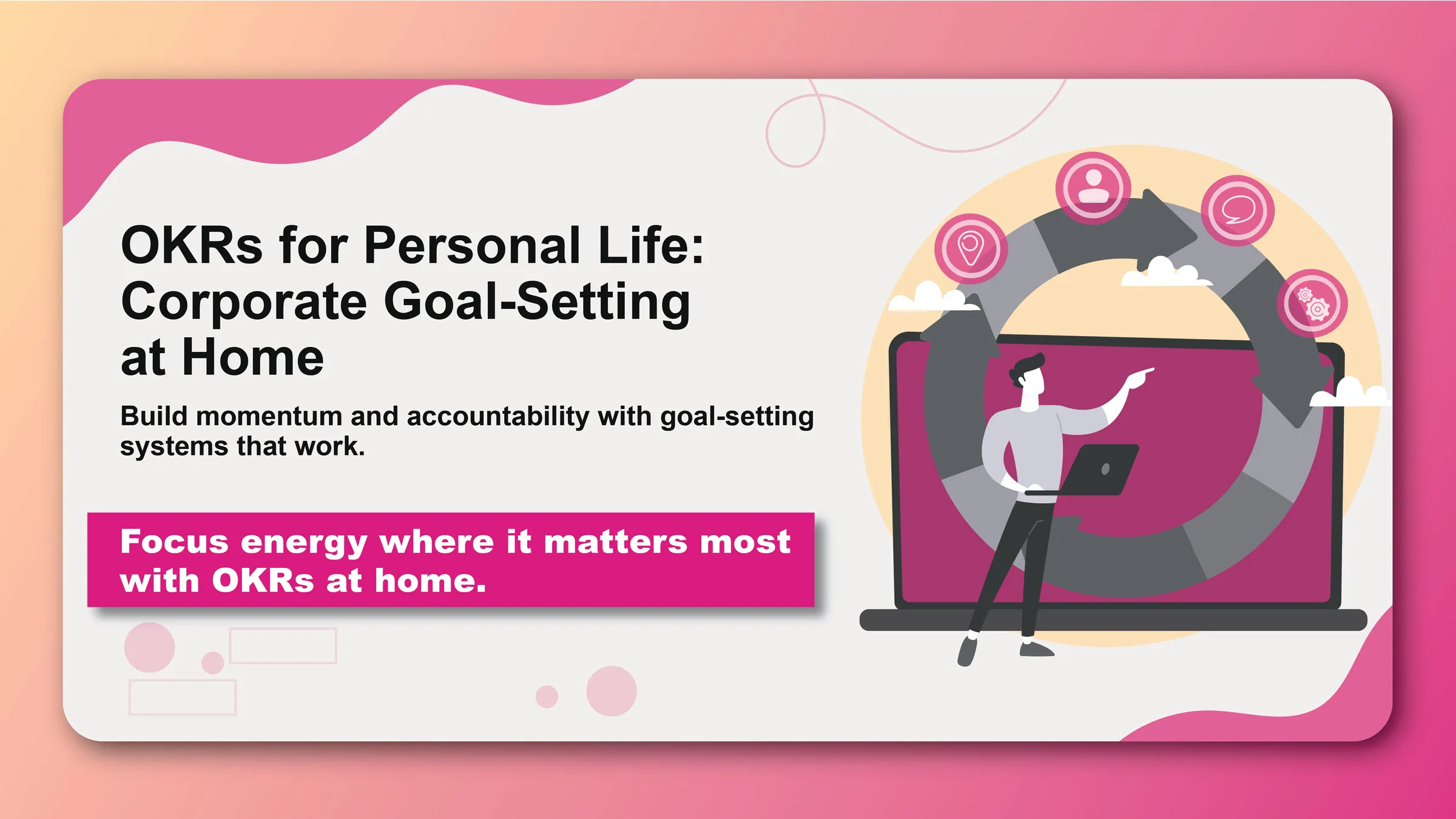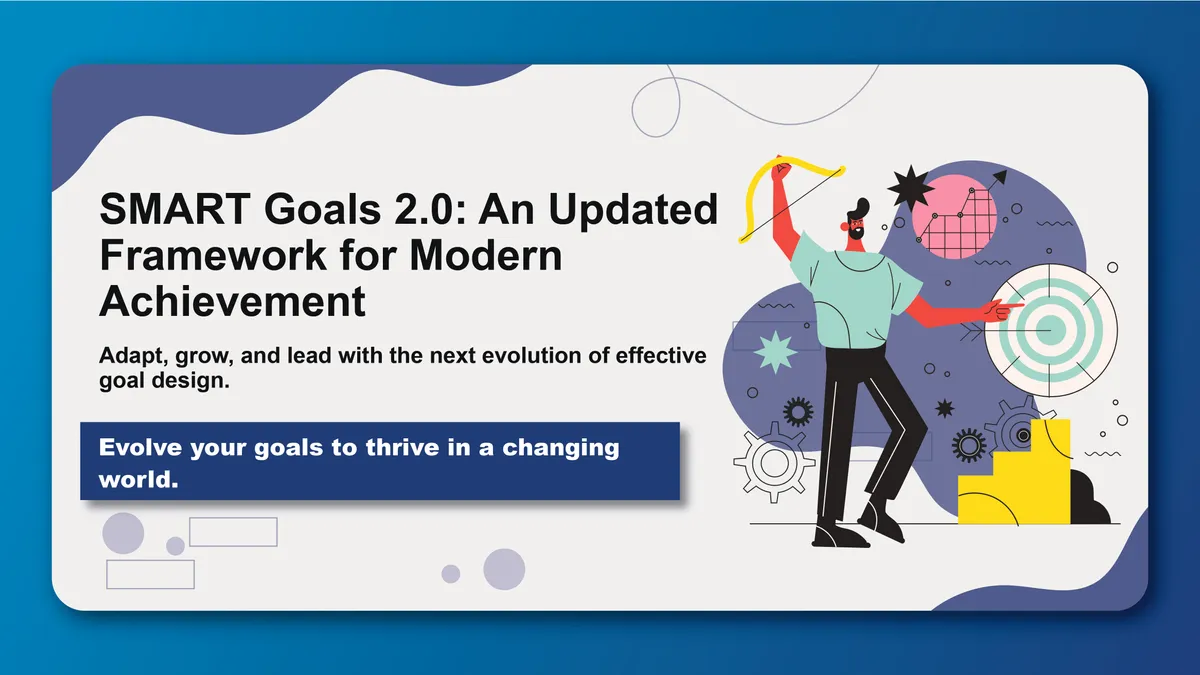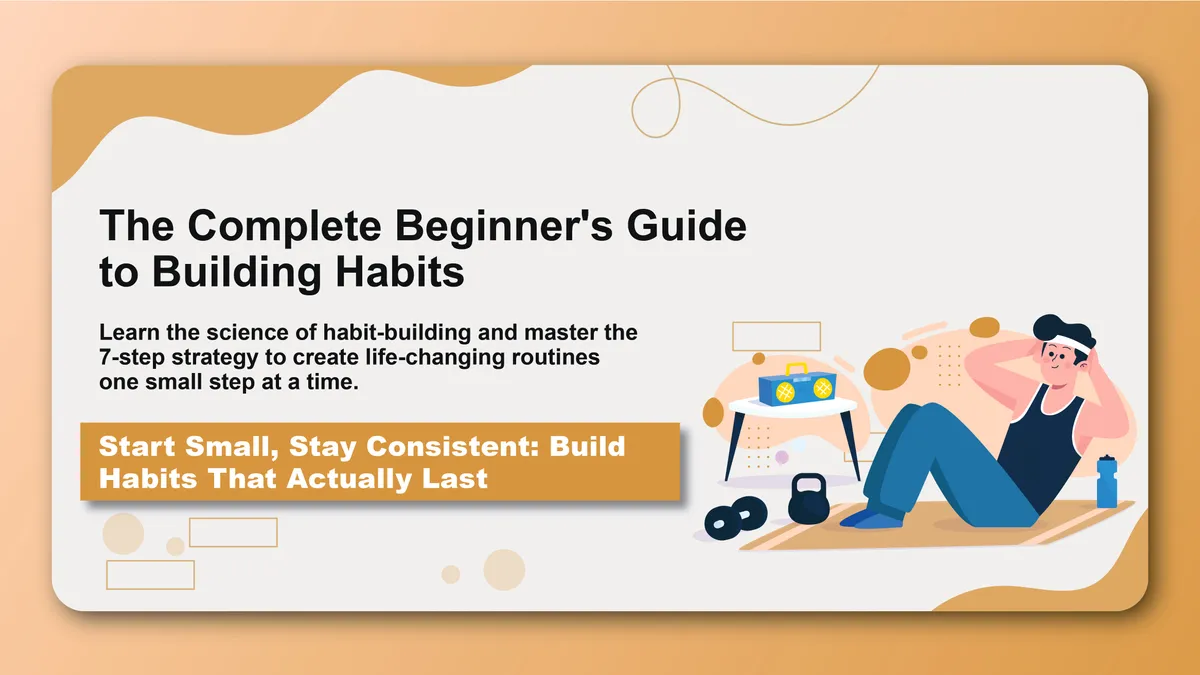In the boardrooms of Google, Intel, and hundreds of other high-performing companies, a simple but powerful framework drives extraordinary results: OKRs (Objectives and Key Results). This system, popularized by legendary Intel CEO Andy Grove and refined by companies like Google, has helped organizations achieve ambitious goals and maintain focus in complex environments.
But what if you could harness this corporate-grade goal-setting system for your personal life? What if the same framework that drives billion-dollar companies could accelerate your individual growth, clarify your priorities, and help you achieve your most meaningful objectives?
Personal OKRs represent a fascinating intersection of corporate effectiveness and individual achievement. By adapting this proven business framework to personal use, you can bring the same level of clarity, focus, and results-orientation that drives successful companies to your own life goals.
The beauty of OKRs lies in their simplicity and power. They force you to think big (Objectives) while staying grounded in measurable reality (Key Results). They create alignment between your daily actions and your deepest aspirations. Most importantly, they provide a clear, actionable system for turning dreams into achievements.
Understanding the OKR Framework
The Basic Structure
Objectives: What you want to achieve
- Qualitative, inspirational, and memorable
- Significant and motivating
- Time-bound (usually quarterly or annual)
Key Results: How you'll know you've achieved the objective
- Quantitative and measurable
- Specific and verifiable
- Typically 3-5 key results per objective
The Corporate OKR Formula
Objective: I will achieve this qualitative goalKey Result 1: As measured by specific metricKey Result 2: As measured by specific metricKey Result 3: As measured by specific metric
Why OKRs Work in Business
Strategic Alignment: Everyone knows how their work contributes to company goals Focus: Limited number of objectives prevents spreading efforts too thin Transparency: OKRs are visible across the organization Accountability: Regular check-ins ensure progress and course correction Stretch Goals: Ambitious objectives inspire breakthrough performance
Adapting OKRs for Personal Use
Key Differences from Corporate OKRs
Individual vs. Team Focus Personal OKRs don't require coordination with others, allowing for more flexibility and personal customization.
Holistic Life Areas Unlike corporate OKRs that focus on business metrics, personal OKRs can span career, health, relationships, personal growth, and other life domains.
Flexibility in Timeline Personal OKRs can use different time horizons—annual, quarterly, or even project-based—depending on the objective.
Different Success Metrics Personal key results might include qualitative measures that matter to you but wouldn't work in a corporate environment.
Personal OKR Categories
Career and Professional Development
- Skill acquisition and certifications
- Network building and relationship development
- Performance improvements and promotions
- Career transitions and new opportunities
Health and Wellness
- Physical fitness and nutrition goals
- Mental health and stress management
- Sleep and recovery optimization
- Preventive health measures
Relationships and Social Life
- Deepening existing relationships
- Building new meaningful connections
- Community involvement and contribution
- Family and partnership goals
Personal Growth and Learning
- Skill development and education
- Creative pursuits and hobbies
- Spiritual or philosophical development
- Self-awareness and emotional intelligence
Financial and Material Goals
- Income and savings targets
- Investment and wealth building
- Debt reduction and financial health
- Major purchases and financial milestones
Contribution and Impact
- Volunteer work and community service
- Mentoring and helping others
- Creative projects and sharing knowledge
- Environmental and social responsibility
Creating Your Personal OKR System
Step 1: Life Assessment and Vision Clarification
Current State Analysis
- What are your current strengths and achievements?
- What areas of your life need improvement or attention?
- What opportunities are available to you right now?
- What challenges or obstacles are you facing?
Future Vision Development
- What does your ideal life look like in 1-3 years?
- What would you regret not pursuing or achieving?
- What would make you feel most fulfilled and proud?
- How do you want to grow and develop as a person?
Step 2: Objective Setting
Characteristics of Good Personal Objectives
- Inspirational and emotionally engaging
- Specific enough to provide direction
- Ambitious but achievable
- Aligned with your values and vision
- Time-bound with clear deadlines
Examples of Personal Objectives
- "Become a confident public speaker and thought leader in my field"
- "Build a strong, healthy body that supports an active lifestyle"
- "Develop deep, meaningful relationships with family and friends"
- "Create financial security and freedom through smart money management"
- "Contribute meaningfully to my community and causes I care about"
Step 3: Key Results Development
Effective Key Results Criteria
- Quantifiable and measurable
- Specific and verifiable
- Challenging but achievable
- Directly connected to the objective
- Limited in number (3-5 per objective)
Types of Personal Key Results
- Quantitative metrics (numbers, percentages, amounts)
- Completion-based results (finish project, complete course)
- Behavioral indicators (frequency of activities)
- Qualitative measures (survey results, feedback)
- Milestone achievements (reach specific levels)
Step 4: Personal OKR Examples
Career Development ObjectiveObjective: "Become a recognized expert in data science and advance to senior leadership role" Key Result 1: Complete advanced machine learning certification with 90%+ score Key Result 2: Publish 4 technical articles in industry publications Key Result 3: Speak at 3 professional conferences or meetups Key Result 4: Receive promotion to Senior Data Scientist role Key Result 5: Build professional network of 50+ meaningful connections
Health and Fitness ObjectiveObjective: "Build exceptional physical health and energy for an active lifestyle" Key Result 1: Achieve and maintain 12% body fat percentage Key Result 2: Complete first marathon in under 4 hours Key Result 3: Deadlift 2x bodyweight and bench press 1.5x bodyweight Key Result 4: Maintain 7+ hours of quality sleep 80% of nights Key Result 5: Complete comprehensive health screening with all metrics in optimal range
Relationship and Social ObjectiveObjective: "Cultivate deep, meaningful relationships and strong social connections" Key Result 1: Have monthly one-on-one quality time with 5 closest friends Key Result 2: Plan and execute 4 memorable experiences with family Key Result 3: Join and actively participate in 2 community groups or clubs Key Result 4: Mentor 2 junior colleagues or students Key Result 5: Organize 6 social gatherings bringing people together
Financial Security ObjectiveObjective: "Build strong financial foundation for future security and freedom" Key Result 1: Increase annual income by 25% through promotion or side income Key Result 2: Save $50,000 in emergency fund (6 months expenses) Key Result 3: Invest $30,000 in diversified portfolio Key Result 4: Reduce monthly expenses by 15% through optimization Key Result 5: Achieve credit score of 800+ and optimize debt structure
Step 5: Implementation and Tracking
Setting Up Your Personal OKR System
Documentation and Tools
- Simple spreadsheet or notion page
- Specialized OKR software (Weekdone, 15Five, or similar)
- Integration with existing productivity systems
- Regular review and update schedule
Review Cadence
- Weekly check-ins for progress updates
- Monthly deep reviews for course correction
- Quarterly comprehensive assessments
- Annual planning and goal setting
Tracking Methods
- Quantitative metrics and data collection
- Qualitative reflection and journaling
- Progress photos and documentation
- Feedback from others and self-assessment
Common Personal OKR Pitfalls and Solutions
Pitfall 1: Too Many Objectives
The Problem: Trying to improve every area of life simultaneously leads to scattered focus and mediocre results.
The Solution:
- Limit yourself to 3-5 objectives maximum
- Focus on the areas that matter most right now
- Sequence objectives if needed rather than pursuing everything at once
- Remember that saying no to good things allows you to say yes to great things
Pitfall 2: Vague or Unmeasurable Key Results
The Problem: Key results that can't be clearly measured make it impossible to track progress and know when you've succeeded.
The Solution:
- Every key result must have a specific number, percentage, or clear completion criteria
- If you can't measure it, redesign the key result
- Use proxy metrics when direct measurement is difficult
- Include deadlines or timeframes for each key result
Pitfall 3: Setting "Easy" Goals
The Problem: Conservative goals that you know you can achieve don't create the stretch and growth that make OKRs powerful.
The Solution:
- Aim for 70% achievement as a success rate
- Set goals that make you slightly uncomfortable
- Include at least one "stretch" key result per objective
- Remember that failing to achieve an ambitious goal often yields better results than succeeding at a mediocre one
Pitfall 4: Neglecting Regular Reviews
The Problem: Setting OKRs and then forgetting about them until the end of the period makes course correction impossible.
The Solution:
- Schedule weekly 15-minute reviews
- Use monthly reviews for deeper analysis and adjustment
- Track leading indicators, not just end results
- Celebrate progress and learn from setbacks
Pitfall 5: All-or-Nothing Thinking
The Problem: Viewing partial achievement as failure discourages continued effort and ignores valuable progress.
The Solution:
- Celebrate progress toward objectives, not just completion
- Analyze what worked and what didn't for future improvement
- Adjust key results mid-period if circumstances change significantly
- Focus on the learning and growth that comes from pursuing ambitious goals
Advanced Personal OKR Techniques
Cascading Personal OKRs
Annual to Quarterly Breakdown
- Set annual aspirational objectives
- Break them down into quarterly executable objectives
- Ensure alignment and progressive achievement
- Adjust based on learning and changing circumstances
Life Area Integration
- Ensure objectives across different life areas support each other
- Identify potential conflicts and address them proactively
- Look for synergies where progress in one area amplifies others
- Balance ambitious objectives with sustainability
OKR Dependencies and Relationships
Prerequisite Objectives Some personal objectives naturally depend on others. Map these relationships to sequence your efforts effectively.
Complementary Goals Identify objectives that reinforce each other and can be pursued simultaneously for compound benefits.
Resource Allocation Understand how different objectives compete for your time, energy, and attention, and plan accordingly.
Personal OKR Scoring and Evaluation
Scoring System
- 0.0-0.3: Significant challenges, little progress
- 0.4-0.6: Made progress but missed the mark
- 0.7-0.9: Achieved most of the goal (target zone)
- 1.0: Completely achieved (possibly too easy)
Evaluation Questions
- What did I achieve that I'm proud of?
- What did I learn about myself and my capabilities?
- What external factors influenced my results?
- How can I improve my approach for next period?
- What should I continue, stop, or start doing?
Integrating OKRs with Daily Life
Daily Actions and OKR Alignment
Morning Intention Setting Begin each day by identifying which OKR-related actions you'll take and why they matter.
Daily Priority Selection Choose your most important daily tasks based on their contribution to your key results.
Evening Reflection Review your day's progress toward your objectives and identify learnings for tomorrow.
Weekly OKR Reviews
Progress Assessment
- How much progress did I make on each key result?
- What obstacles did I encounter and how did I address them?
- What unexpected opportunities emerged?
- What do I need to adjust for next week?
Planning and Prioritization
- What are my top 3 priorities for the coming week?
- How will I allocate my time and energy across objectives?
- What support or resources do I need?
- How will I measure progress?
Monthly Deep Dives
Comprehensive Analysis
- Detailed review of progress against all key results
- Analysis of what's working and what isn't
- Identification of patterns and trends
- Assessment of external factors and their impact
Course Correction
- Adjustments to tactics and approaches
- Reallocation of time and resources
- Modification of key results if circumstances have changed significantly
- Celebration of achievements and learning from setbacks
Technology and Tools for Personal OKRs
Simple Solutions
Spreadsheet Templates
- Google Sheets or Excel templates for basic tracking
- Customizable to your specific needs and preferences
- Easy to share with accountability partners
- Free and accessible
Note-Taking Apps
- Notion, Obsidian, or Roam for comprehensive OKR documentation
- Integration with other productivity systems
- Flexible formatting and organization
- Rich media support for progress documentation
Specialized OKR Software
Dedicated Platforms
- Weekdone: Simple, clean interface for individual OKRs
- 15Five: Comprehensive performance management with OKR features
- Ally: Enterprise-grade OKR platform with personal use options
- Lattice: Performance management platform with OKR capabilities
Integration Options
- Connection with calendar apps for review scheduling
- Integration with habit tracking apps
- Synchronization with project management tools
- Connection with fitness and health tracking apps
Habit Tracking Integration
Connecting Daily Habits to OKRs
- Identify daily habits that support your key results
- Track consistency and frequency of OKR-related activities
- Use habit streaks as leading indicators for key results
- Integrate habit data with OKR progress reviews
Building an OKR Culture in Your Personal Life
Accountability Systems
Personal Accountability
- Regular self-assessment and honest evaluation
- Documentation of progress and setbacks
- Commitment to consistent review and adjustment
- Celebration of progress and learning from failures
Social Accountability
- Share objectives with trusted friends or family
- Regular check-ins with accountability partners
- Join or create an OKR accountability group
- Public commitment to increase motivation and support
Continuous Improvement
Learning Mindset
- Treat each OKR period as an experiment
- Document what works and what doesn't
- Continuously refine your approach
- Stay curious about new techniques and tools
Adaptation and Evolution
- Adjust your OKR system based on what you learn
- Experiment with different time horizons and structures
- Integrate new tools and techniques as they become available
- Maintain flexibility while preserving core principles
Personal OKRs represent a powerful bridge between corporate effectiveness and individual achievement. By adapting this proven framework to your personal life, you can bring the same level of clarity, focus, and results-orientation that drives successful companies to your own goals and aspirations.
The key to success with personal OKRs lies not in perfect execution but in consistent application and continuous learning. Start with a simple system, focus on what matters most, and gradually refine your approach as you gain experience and insight.
Remember that the goal isn't to become a corporation of one, but to harness the power of structured goal-setting to create the life you truly want. When you combine the clarity of objectives with the accountability of key results, you create a system that can transform your aspirations into achievements.
Ready to implement OKRs in your personal life? Track your objectives and key results with Habityzer and experience how corporate-grade goal setting can accelerate your individual achievement and growth.



